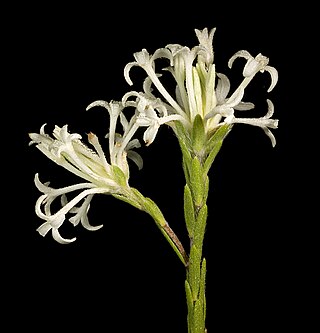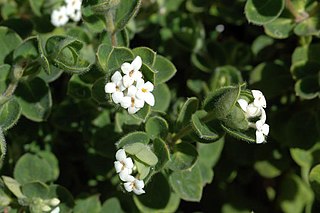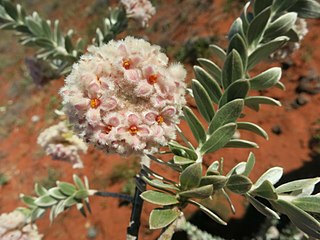
Pimelea drupacea, commonly known as cherry rice-flower, is a species of flowering plant in the family Thymelaeaceae and is endemic to south-eastern Australia. It is a shrub with elliptic leaves arranged in opposite pairs, and head-like clusters of white, tube-shaped flowers surrounded by two or four leaves.

Pimelea longiflora is a species of flowering plant in the family Thymelaeaceae and is endemic to the southwest of Western Australia. It is an erect, spindly shrub with linear to narrowly elliptic leaves and erect clusters of white to cream-coloured flowers, surrounded by 4 to 6 green, egg-shaped involucral bracts.

Pimelea altior is a species of flowering plant in the family Thymelaeaceae and is endemic to eastern Australia. It is a shrub with elliptic leaves and heads of white, tube-shaped flowers.

Pimelea amabilis is a species of flowering plant in the family Thymelaeaceae and is endemic to northern Queensland. It is a small shrub with narrowly elliptic or elliptic leaves and spikes of hairy, yellowy-green or yellow, tube-shaped flowers.
Pimelea approximans is a species of flowering plant in the family Thymelaeaceae and is endemic to northern Queensland. It is a perennial shrub with elliptic leaves and spikes of hairy, yellow, tube-shaped flowers.
Pimelea aquilonia is a species of flowering plant in the family Thymelaeaceae and is endemic to far north Queensland. It is a shrub with narrowly elliptic leaves and small clusters of hairy, white or cream-coloured, tube-shaped flowers.

Pimelea argentea, commonly known as silvery leaved pimelea, is a species of flowering plant in the family Thymelaeaceae and is endemic to the south-west of Western Australia. It is an erect shrub with densely hairy young stems and leaves, the leaves linear to elliptic, and heads of white to yellow or greenish flowers, the male and female flowers on separate plants.
Pimelea chlorina is a species of flowering plant in the family Thymelaeaceae and is endemic to north Queensland. It is a shrub with silvery, elliptic or egg-shaped leaves and clusters of greenish-yellow, tube-shaped flowers.
Pimelea elongata is a species of flowering plant in the family Thymelaeaceae and is endemic to inland areas of eastern Australia. It is a slender forb with linear to narrowly elliptic leaves and spikes of hairy, yellowish-green flowers.
Pimelea erecta is a species of flowering plant in the family Thymelaeaceae and is endemic to the southwest of Western Australia. It is an erect, often spreading shrub with elliptic to egg-shaped leaves arranged in opposite pairs, and clusters of erect, white or pale pink flowers.
Pimelea eyrei is a species of flowering plant in the family Thymelaeaceae and is endemic to the southwest of Western Australia. It is an erect shrub with hairy, narrowly elliptic leaves and clusters of densely hairy, white or cream-coloured flowers.

Pimelea confertiflora is a species of flowering plant in the family Thymelaeaceae and is endemic to north Queensland. It is a shrub with densely hairy young stems, elliptic or narrowly elliptic leaves and spikes of yellowish-green or yellow, tube-shaped flowers.
Pimelea fugiens is a species of flowering plant in the family Thymelaeaceae and is endemic to central Queensland. It is a shrub with elliptic leaves and heads of 12 to 18 pale yellow, tube-shaped flowers.

Pimelea gigandra is a species of flowering plant in the family Thymelaeaceae and is endemic to eastern Australia. It is a shrub with densely hairy young stems, elliptic leaves and heads of 10 to 19 white, tube-shaped flowers.

Pimelea interioris is a species of flowering plant in the family Thymelaeaceae and is endemic to a restricted part of the south of the Northern Territory of Australia. It is a shrub with hairy, narrowly elliptic leaves and clusters of creamy-white to pale yellow, separate male and female flowers.

Pimelea latifolia is a species of flowering plant in the family Thymelaeaceae and is endemic to eastern Australia. It is a shrub with hairy young stems, egg-shaped leaves with the narrower end towards the base, and greenish-yellow to white, tube-shaped flowers.

Pimelea leiophylla is a species of flowering plant in the family Thymelaeaceae and is endemic to Tasmania. It is a shrub with silky-hairy young stems, broadly elliptic to egg-shaped leaves, and clusters of 15 to 25 or more, bright white or pink, tube-shaped flowers surrounded by 4 or 8 involucral bracts.
Pimelea leptospermoides, commonly known as serpentine rice flower, is a species of flowering plant in the family Thymelaeaceae and is endemic to Queensland. It is a shrub with narrowly egg-shaped to elliptic leaves and white, tube-shaped flowers arranged in groups of up to 7.
Pimelea leptostachya is a species of flowering plant in the family Thymelaeaceae and is endemic to central Queensland. It is a shrub with narrowly elliptic leaves and spikes of maroon or yellow, tube-shaped flowers arranged in groups of 13 to 23.
Pimelea milliganii, commonly known as silver riceflower or Milligan's rice flower, is a species of flowering plant in the family Thymelaeaceae and is endemic to a restricted part of Tasmania. It is a low, much-branched, densely hairy shrub with more or less elliptic leaves and compact clusters of white to pinkish flowers usually surrounded by two leaf-like involucral bracts.









